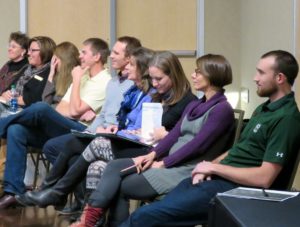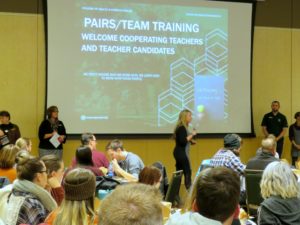On Dec. 15, the School of Education’s Center for Educator Preparation at Colorado State University and Poudre School District co-hosted a professional development workshop focused on the importance and implementation of co-teaching in the classroom. This workshop was offered to current teachers, principals and student-teachers, and was designed to assist in the successful implementation of the co-planning and co-teaching strategies throughout the student-teacher experience. Participants also learned how to analyze the ways in which relationship-building, collaboration, and communication impact the co-teaching practice.
School district collaboration
 Although this is the fourth year the activity-based workshop was offered, this was the first time the workshop was a collaborative effort between CEP and PSD, as well as the first time the workshop offered professional development credit for current educators.
Although this is the fourth year the activity-based workshop was offered, this was the first time the workshop was a collaborative effort between CEP and PSD, as well as the first time the workshop offered professional development credit for current educators.
“It’s great to work with a partner school district that is interested in engaging and supporting new ideas around teaching,” said Jody Drager, CEP’s student teacher coordinator.
The evening began with a general discussion of co-teaching. Historically, co-teaching was designed for general education teachers and special education teachers to teach together in the classroom. CEP is implementing co-teaching within the student teaching experience in an effort to best prepare new teachers while at the same time benefitting the PK-12 students and the cooperating teachers with whom they are teaching. CEP defines co-teaching as “two or more teachers working together with groups of students and sharing the planning, organization, delivery and assessment of instruction and physical space.” Importantly, states CEP, co-teaching requires a shift in attitude.
“We are all teachers,” Drager said, “and we are all actively engaged in kids’ learning.”
Likewise, Drager continued, co-teaching is collaborative.
“Administrators and district personnel strongly seek teacher candidates who are prepared to collaborate. CEP and PSD believe that co-teaching is an avenue to learn, practice, and fine-tune collaboration skills which are needed in today’s teaching world.”
The workshop explained that there are seven methods to co-teaching:
- One Teach, One Observe
- One Teach, One Assist
- Station Teaching
- Parallel Teaching
- Supplemental Teaching
- Alternative/Differentiated Teaching
- Team Teaching
Co-teaching benefits
 These various methods offer benefits for students, teacher candidates and cooperating teachers alike, and researchers from St. Cloud State University in St. Cloud, Minnesota, have found a statistically significant positive effect on reading and math scores for students in co-taught classrooms, as compared to the traditional model of student teaching.1
These various methods offer benefits for students, teacher candidates and cooperating teachers alike, and researchers from St. Cloud State University in St. Cloud, Minnesota, have found a statistically significant positive effect on reading and math scores for students in co-taught classrooms, as compared to the traditional model of student teaching.1
Beyond the statistical research, another reason for the co-teaching model is Colorado Senate Bill 10-191, which was implemented and July 2013. The Colorado Department of Education states, “Senate Bill 10-191 changes the way all educators (principals/assistant principals, teachers and specialized service professionals) will be evaluated in Colorado with the ultimate goal of continuously supporting educators’ professional growth and, in turn, accelerating student results.”
The interest in co-teaching continues to grow locally—Drager explains that CEP’s very first co-teaching workshop in 2012 attracted 18 attendees; the most recent workshop attracted over 120.
“Additionally,” she says, “we are very excited to be working with some of our surrounding partner schools on supplemental co-teaching training for their staff members.”
These workshops will include administrators, classroom teachers, paraprofessionals and specialists, and will be designed around the individual needs of each school.
“As a Professional Development Model Teacher Preparation program,” Drager says, “we believe in professional development that is mutually beneficial for our teacher candidates and our partner schools.”
‘Complementary personalities’
Paul Binkley, a recent graduate of CSU’s English Education master’s degree program and a panelist at the workshop, said, “For both me and my students, one simple way that [co-teaching] helped us was that it made our class size of 37 more manageable. It was really valuable for one of us to be able to work with some students more directly.
“Working with a co-teacher whose personality and pedagogy complemented mine meant that our students got two different approaches to planning and instruction that worked together as a more effective whole than either of our approaches would have been individually. There were students that responded more to her and students that responded more to me.
“And in regards to our complementary personalities, one of my students captured it well in some feedback she or he wrote: ‘Mr. Binkley was the calmness in Mrs. Goldberg’s storm.'”
To see photos from the workshop, visit our Flickr album.
1Bacharach, N., Washut-Heck, T., & Dahlberg, K. (2010). Changing the face of student teaching through co-teaching. Action in Teacher Education 32(1), 3-14.